Phytochemical Analysis and Antioxidant Activity of Ficus exasperata
| Received 02 Dec, 2024 |
Accepted 01 Mar, 2025 |
Published 31 Mar, 2025 |
Background and Objective: In recent years, the prevention of oxidative stress and exploration of medicinal plants' potentials to combat it has driven extensive research. This study investigates the phytochemical composition, antioxidant properties, and mineral content of ethyl acetate extracts from fermented and unfermented Ficus exasperata leaves, emphasizing the effects of fermentation on these parameters. The antioxidant capacity of both extracts was evaluated using the total phenolic and flavonoid content and ferric reducing antioxidant power assay. Materials and Methods: Ficus exasperata leaf was divided into two portions in which one was wrapped with plantain leaves to facilitate fermentation. Both samples were dried at room temperature and milled into powder. Ethyl acetate extracts of each sample (5 and 5 g/100 mL of fermented and unfermented, respectively) were prepared to determine phenolic contents and antioxidant capacity. Statistical analysis was performed using One-way ANOVA followed by Dunnett's post hoc test, considering p<0.05 as significant. Results: The results showed that unfermented extract exhibited a higher significant difference (p<0.05) in antioxidant property. The HPLC analysis follows the same trend with the identification of several bioactive compounds, including caffeic acid, ferulic acid, tannic acid, salicylic acid, apigenin, and naringenin in high concentration in the unfermented extract, which are known for their antioxidant and anti-inflammatory properties. Conversely, the fermented extract displayed altered phytochemical profiles, characterized by the appearance of quercetin and an increase in caffeic acid and p-coumaric acid, alongside a reduction in ferulic acid. Mineral analysis indicated that both extracts contained essential minerals, with the unfermented extract having higher concentrations of calcium, magnesium, potassium, and sodium. Conclusion: However, the fermented extract demonstrated increased levels of iron and manganese, suggesting enhanced bioavailability of these minerals post-fermentation. The overall results of the analysis showed that the unfermented extract of F. exasperata had higher antioxidant activity, phenolic contents, minerals, and HPLC-identified contents. However, the fermented F. exasperata may offer distinct health benefits, particularly regarding mineral absorption.
INTRODUCTION
Medicinal plants are widely recognized for their effectiveness in treating various diseases in both humans and animals1. One such plant is the sandpaper leaf, scientifically known as Ficus exasperata Vahl leaf (FEVL), which exhibits diverse medicinal properties2. This plant is commonly distributed across tropical Africa, spanning countries such as Mozambique, Zambia, Northern Angola, Senegal, and Ethiopia, as well as parts of the Southern Arabian Peninsula and India3. Toxicological and phytochemical studies on Ficus exasperata have identified several bioactive compounds, including flavonoids, tannins, saponins, alkaloids, and glycosides4,5. Research conducted in Western Nigeria has further demonstrated the plant’s therapeutic potential, revealing that its leaves exhibit antiulcer, hypotensive, hypoglycemic, hypolipidemic, anti-inflammatory, anxiolytic, oxytocin-inhibiting, anticonvulsant, antinociceptive, antimicrobial, anti candidal, insecticidal, and pesticidal activities6. Furthermore, decoctions and infusions of Ficus exasperata leaves have traditionally been used to manage and treat diseases such as diabetes mellitus, hypertension, and various cardiovascular disorders7. This study advances new knowledge in the field by providing a comprehensive phytochemical profile of Ficus exasperata leaves, identifying key bioactive compounds responsible for its antioxidant potential. Unlike previous studies that primarily focused on its traditional medicinal uses, this research employs advanced in vitro antioxidant assays to quantify its free radical scavenging activity. By establishing a correlation between specific phytochemicals and antioxidant efficacy, the study enhances the understanding of Ficus exasperata as a potential natural source of antioxidants. These findings contribute to the growing body of evidence supporting the use of plant-based antioxidants in pharmaceutical and nutraceutical applications.
MATERIALS AND METHODS
Study area: The research was carried out in the Ondo State Region of Akungba-Akoko, a semi-rural settlement where the major occupation of the populace is farming and trading of food items. Ondo State has a boundary with neighboring states on the East-Edo and Delta, on the West-Ogun and Osun, on the North-Ekiti and Kogi, and the South Atlantic Ocean. Ondo State is located on the Latitude 5°45° and 7°52° and Longitude 4°20° and 6°05°E.
Every analysis was carried out between the months of June-August, 2024 at the Adekunle Ajasin University, Department of Biochemistry in Akungba Akoko, Ondo State, Nigeria.
Chemicals and reagents: All chemicals and reagents used for this were of analytical grade, quercetin, gallic acid, ethanol, folin-ciocalteu reagent, Sodium Carbonate (Na2CO3), Potassium Acetate, Aluminum Chloride (AlCl3), Methanol, Iron (III) Chloride (FeCl3), Potassium Ferricyanide (K3Fe(CN)6), Trichloroacetic Acid (TCA) were purchased from Sigma-Aldrich, Inc., (St Louis, USA). The distilled water used was obtained from the Biochemistry Department at Adekunle Ajasin University, Akungba Akoko, Ondo State, Nigeria. Optical absorbance was measured with a 721S Visible spectrophotometer (Searchtech instrument).
Plants collection: The leaf of Ficus exasperata was obtained from Akungba Akoko, Ondo State, Nigeria. It was identified by Dr (Mrs) Shodehinde of the Department of Biochemistry, Adekunle Ajasin University, Akungba Akoko, Ondo State.
Preparation of extracts: Fresh leaves of Ficus exasperata were cut and thoroughly washed with potable water to eliminate contaminants. The leaves were then spread out under shade to drain completely. A portion of the drained leaves was wrapped in plantain leaves to encourage fermentation, while the remaining leaves were left unwrapped and air-dried at room temperature for three weeks. Once dried, the leaves were ground into a fine powder and stored in airtight containers for extraction. For the extraction process, 90 g of fermented and 90 g of unfermented powdered leaves were separately soaked in 1000 and 1000 mL of ethyl acetate for 72 hrs. After steeping, the mixtures were filtered, the residue dried, and the filtrate evaporated over 2 weeks. Upon drying, 100 mL of distilled water was added to 5 g of the dried filtrate from the fermented sample, while 100 mL of distilled water was added to 5 g of the unfermented sample, each in separate bottles. The mixtures were shaken in a water bath for uniformity, filtered through filter paper, and the resulting filtrates were used in biochemical assays to evaluate the in vitro antioxidant activity of the samples.
In vitro assay determination
Determination of total phenol content: The total phenol content was determined according to the method of Singleton et al.8. Briefly, appropriate dilutions of the extracts were oxidized with 2.5 mL of 10% Folin-Ciocalteu reagent (v/v) and neutralized by 2.0 mL of 7.5% sodium carbonate. The reaction mixture was incubated for 40 min at 45°C and the absorbance was measured at 765 nm. The total phenol content was subsequently calculated as gallic acid equivalent (GAE).
Determination of flavonoids content: The total flavonoid content of the extract was determined using a slightly modified method reported by Meda et al.9. Briefly, 0.5 mL of appropriately diluted sample was mixed with 0.5 mL methanol, 50 μL of 10% AlCl3, 50 μL of 1M potassium acetate and 1.4 mL water, and allowed to incubate at room temperature for 30 min. Thereafter, the absorbance of the reaction mixture was subsequently measured at 415 nm. The total flavonoid was calculated using quercetin as standard.
Determination of ferric reducing antioxidant property: The reducing property of the extracts will be determined by assessing the ability of the extract to reduce FeCl3 solution as described by Oyaizu10. About 2.5 mL aliquot was mixed with 2.5 mL of 200 mM sodium phosphate buffer (pH 6.6) and 2.5 mL of 1% potassium ferricyanide. The mixture was incubated at 50°C for 20 min. Then 2.5 mL of 10% trichloroacetic acid was added. The mixture was centrifuged at 650 rpm for 10 min. About 5 mL of the supernatant was measured with an equal volume of water and 1 mL of 0.1% ferric chloride. The absorbance was measured at 700 nm. The ferric-reducing antioxidant property was subsequently calculated.
HPLC analysis: The High-Performance Liquid Chromatography (HPLC) analysis of both the fermented and unfermented Ficus exasperata (FE) sample was performed using a NIMR 1260LC instrument equipped with a Poros hell 120 EC C18 column (4 μm, 150×4.6 mm). The mobile phase consisted of acetonitrile (ACN) and 0.1% formic acid in a 70:30 ratio. The flow rate was maintained at 0.700 mL/min, while the column temperature was set to 28°C. The detection was carried out at a wavelength of 257 nm using a diode array detector (DAD). For each injection, a sample volume of 20 μL was used. Standard compounds such as caffeic acid, ferulic acid, maleic acid, salicylic acid, apigenin, naringenin, and p-coumaric acid were identified based on their retention times. The data was analyzed using the Chem Station software, and the retention times were compared against reference standards to confirm the identity of the compounds present in the sample.
Atomic absorption spectroscopy (AAS)
Digestion procedure: About 1 g of the sample was taken into a 250 mL conical flask, 10 mL of conc. Nitric acid was added and the mixture was placed on a hot plate for about 35 min until the brown fumes started forming and the fume changed gradually to whitish, which shows that the samples have been completely digested. The digested samples were allowed to cool and later made up to 25 mL mark with purified water, the mixture was filtered through a micro glass filter or clean filter paper, and the samples were ready for AAS analysis.
Statistical analysis: GraphPad Prism 8 was used for the statistical analysis, statistical significance was evaluated using One-Way Analysis of Variance (ANOVA), followed by Dunnett's post hoc test. Data points correspond to the mean of independent experiments and error bars (SEM); the level of significance was set at p<0.05.
RESULTS
Total phenol: The total phenol content of ethyl acetate extracts of Ficus exasperata leaves, as presented above, reveals significant differences between fermented and unfermented samples when compared to the gallic acid standard. The unfermented Ficus exasperata extract showed a moderate level of phenols, significantly lower than the standard (p<0.05), but higher than the fermented extract. This suggests that unfermented leaves contain a substantial amount of phenolic compounds, which are important contributors to antioxidant activity. In contrast, the fermented extract displayed the lowest phenolic content, significantly lower than both the unfermented extract and standard (p<0.05 for both comparisons). The reduction in total phenols during fermentation could be attributed to the breakdown or degradation of phenolic compounds, which could explain the lower antioxidant activity observed in the fermented sample (Fig. 1).
Total flavonoid: The result showed a significant difference (p<0.05) in which the total flavonoid content of the ethyl acetate extract of unfermented Ficus exasperata leaf had the highest concentration when compared to its fermented counterpart (Fig. 2).
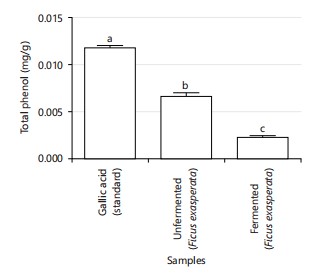
|
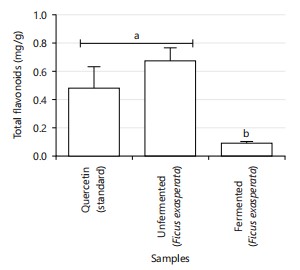
|
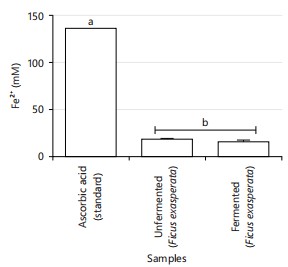
|
| Table 1: | Concentration of polyphenolic contents in fermented F. exasperata leaf | |||
| Compounds | Concentration (mg/g) |
| Caffeic acid | 4.59 |
| Ferulic acid | 4.17 |
| Maleic acid | 7.01 |
| Quercetin | 214.63 |
| p-coumaric acid | 311.64 |
| Table 2: | Concentration of polyphenols present in unfermented F. exasperata leaf | |||
| Compounds | Concentration (mg/g) |
| Caffeic acid | 3.81 |
| Ferulic acid | 4.42 |
| Tannic acid | 5.53 |
| Maleic acid | 4.68 |
| Salicylic acid | 11.14 |
| Apigenin | 3.32 |
| Naringenin | 37.95 |
| p-coumaric acid | 21.40 |
Ferric reducing antioxidant property: The ferric reducing antioxidant power (FRAP) result, as shown above, evaluates the antioxidant capacity of ethyl acetate extracts of Ficus exasperata leaves, comparing both fermented and unfermented samples to ascorbic acid (standard). The results show no significant difference (p>0.05) when both samples are compared to each other, but statistically different (p<0.05) when compared to the standard (Fig. 3).
HPLC analysis: The HPLC analysis of Ficus exasperata leaf demonstrates significant variations in the phytochemical profiles of unfermented and fermented ethyl acetate extracts. The fermented sample contains caffeic acid (4.59 mg/g), ferulic acid (4.17 mg/g), maleic acid (7.01 mg/g), quercetin (214.63 mg/g), and p-coumaric acid (311.64 mg/g), with notable increases in the concentrations of caffeic acid, maleic acid, and p-coumaric acid compared to the unfermented extract. This enhancement suggests that fermentation boosts the extraction or availability of these phenolic compounds, potentially elevating the extract's bioactivity (Fig. 4 and Table 1).
The unfermented extract is rich in phenolic acids and flavonoids, containing compounds such as caffeic acid (3.81 mg/g) with the least concentration, ferulic acid (4.42 mg/g), tannic acid (5.53 mg/g), maleic acid (4.68 mg/g), salicylic acid (11.14 mg/g), apigenin (3.32 mg/g), naringenin (37.95 mg/g), and p-coumaric acid (214 mg/g). These compounds are recognized for their antioxidant, anti-inflammatory, and bioactive properties, indicating that the unfermented extract may offer various health benefits (Fig. 5 and Table 2).
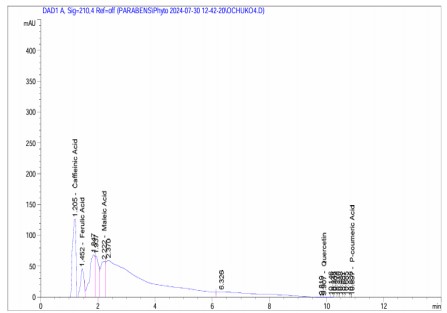
|
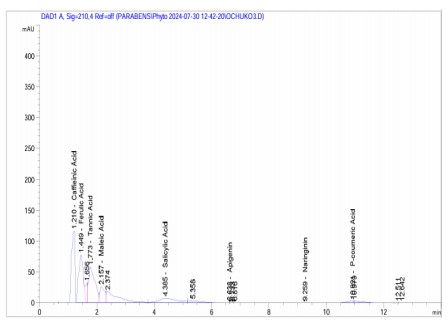
|
Mineral analysis (mg/kg): The mineral analysis conducted in this study revealed the presence of several essential minerals, including calcium, magnesium, iron, copper, manganese, potassium, sodium, and zinc in both fermented and unfermented Ficus exasperata leaf extracts in Table 3. The unfermented extract exhibited the highest concentrations of most minerals, indicating that it retained a greater overall mineral content. This is particularly significant for minerals like calcium, magnesium, potassium, and zinc, which play critical roles in various physiological functions, such as bone health, enzyme activity, and maintaining electrolyte balance. Interestingly, the levels of iron and manganese were significantly higher in the fermented extract compared to the unfermented one. Although the unfermented Ficus exasperata leaf extract generally contains higher levels of most minerals, fermentation appears to selectively increase the availability of iron and manganese. This result suggests that the choice between using fermented or unfermented extracts could depend on the specific mineral benefits desired from Ficus exasperata.
| Table 3: | Showing the concentration of minerals in both fermented and unfermented Ficus exasperata | |||
| Mineral contents (mg/g) | Calcium | Magnesium | Iron | Copper | Manganese | Potassium | Sodium | Zinc |
| Fermented F. exasperata | 23.96 | 30.08 | 7.05 | 1.85 | 2.08 | 2.57 | 3.08 | 10.6 |
| Unfermented F. exasperata | 36.85 | 40.13 | 6.35 | 2.05 | 1.89 | 3.86 | 4.89 | 15.08 |
DISCUSSION
Reactive oxygen species (ROS), commonly known as free radicals, are generated in the body through exposure to external chemicals and internal metabolic processes. When ROS levels become excessive, they disrupt the balance between oxidants and antioxidants, resulting in oxidative stress. This imbalance can lead to damage of vital biomolecules, including nucleic acids, proteins, lipids, and DNA, potentially contributing to the development of conditions such as cancer, cardiovascular diseases, muscular degeneration, neurological disorders, and various inflammatory processes. Therefore, maintaining a balance between free radicals and antioxidants is essential for overall biological health11. The intake of external antioxidants can help counteract oxidative stress by slowing or preventing oxidative chain reactions. These antioxidants act as free radical scavengers, singlet oxygen quenchers, and reducing agents, thereby mitigating the damage caused by oxidative stress12.
Plant-based materials have gained significant attention due to their versatile uses, and many plants have been explored as potential sources of natural antioxidants13. In particular, phenolic and flavonoid compounds from plants have demonstrated strong antioxidant and free radical-scavenging properties14. In this present study, the results from Fig. 1-3 show that unfermented Ficus exasperata leaf extract exhibited significantly higher antioxidant activity, as indicated by the total phenol and flavonoid contents and the ferric reducing antioxidant property. This observation is consistent with several studies that have demonstrated the strong correlation between phenolic content and antioxidant capacity. Phenolic compounds, known for their electron-donating properties, are key contributors to the neutralization of free radicals and oxidative stress. Plants belonging to the Ficus species are widely recognized for their significance in traditional medicine. The retention of higher levels of phenolics and flavonoids in the unfermented plant extracts has led to its superior antioxidant activity compared to their fermented counterparts. However, fermentation appears to significantly reduce the total phenol content, diminishing their potential antioxidant activity.
The HPLC characterization revealed the presence of key phenolic compounds (Fig. 4-5) in fermented and unfermented extracts. Fermentation led to the appearance of quercetin and an increase in caffeic acid and p-coumaric acid concentrations (Table 1) as revealed by HPLC analysis. Quercetin has been shown to exhibit antioxidant properties by effectively scavenging reactive oxygen species15, which showed that fermentation can induce the synthesis of flavonoids such as quercetin through microbial biotransformation. The p-coumaric acid, a hydroxylated derivative of cinnamic acid, helps prevent the oxidation of low-density lipoproteins and decreases the risk of stomach cancer16, caffeic acid (CA) functions as both a primary and secondary antioxidant. As a primary antioxidant, it prevents the formation of free radicals by disrupting chain reactions with other molecules17.
The unfermented extract contains several bioactive compounds including caffeic acid, ferulic acid, maleic acid, p-coumaric acid, tannic acid, salicylic acid, apigenin, and naringenin (Table 2). These compounds are well-documented for their antioxidant, anti-inflammatory, and antimicrobial activities. Ferulic acid plays a vital role in protecting fatty acids within cell membranes from harmful autoxidation. As a secondary metabolite, it and its derivatives can chelate copper and iron ions, thereby inhibiting the formation of destructive hydroxyl radicals that contribute to cellular damage18. Salicylic acid (SA) is a naturally occurring plant hormone that regulates various physiological processes, including growth, development, and defense mechanisms19. Apigenin and its derivatives are well known for their antioxidant, anti-inflammatory, and anti-carcinogenic properties20. Naringenin provides a range of health benefits, including improving carbohydrate metabolism, strengthening antioxidant defenses, neutralizing reactive oxygen species, modulating immune system functions, and demonstrating anti-cancer, anti-inflammatory, and anti-atherosclerotic properties21.
Table 3 shows the mineral analysis of both extracts which revealed that the unfermented extract contained higher concentrations of most minerals, including calcium, magnesium, potassium, sodium, zinc, and copper. The higher concentrations of these minerals in the unfermented plant extracts can be due to the minimal processing they undergo. However, the fermented extract exhibited significantly higher levels of iron and manganese, indicating that fermentation can enhance the bioavailability of certain minerals. The increase in iron content is particularly significant, as iron is a crucial mineral involved in oxygen transport and energy production. Manganese, a key cofactor for several antioxidant enzymes, may contribute to the enhanced enzymatic antioxidant defense in the fermented extract. However, the presence of unique compounds in the fermented extract indicates that fermentation not only modifies the phytochemical composition but also promotes the synthesis of additional bioactive compounds. These newly formed components may contribute to health benefits and could be utilized in managing oxidative stress and associated chronic diseases22.
CONCLUSION
This study highlights the antioxidant potential, phytochemical composition, and mineral profile of Ficus exasperata leaf extracts, comparing unfermented and fermented samples. The unfermented extract demonstrated superior antioxidant activity due to its higher phenol and flavonoid content, while fermentation led to the emergence of quercetin and increased caffeic and p-coumaric acid concentrations. Although fermentation reduced total phenols and antioxidant capacity, it enhanced the bioavailability of iron and manganese. These findings suggest that both unfermented and fermented extracts have potential applications in nutraceuticals and functional foods. Further studies on the mechanistic pathways and in vivo efficacy of these bioactive transformations are recommended.
SIGNIFICANCE STATEMENT
This study provides valuable insights into the effects of fermentation on the phytochemical, antioxidant, and mineral properties of Ficus exasperata leaf extracts. The unfermented extract exhibited higher phenolic content and stronger antioxidant activity, while the fermented extract showed increased bioavailability of iron and manganese and the emergence of quercetin. Future studies should focus on the clinical evaluation of Ficus exasperata extracts to confirm their therapeutic efficacy and explore their potential in managing oxidative stress-related diseases.
REFERENCES
- Roy, A., N. Jauhari and N. Bharadvaja, 2018. Medicinal Plants as a Potential Source of Chemopreventive Agents. In: Anticancer Plants: Natural Products and Biotechnological Implements, Akhtar, M.S. and M.K. Swamy (Eds.), Springer, Singapore, ISBN: 978-981-10-8064-7, pp: 109-139.
- Adekeye, A.O., G.J. Irawo and A.A. Fafure, 2020. Ficus exasperata Vahl leaves extract attenuates motor deficit in vanadium-induced parkinsonism mice. Anat. Cell Biol., 53: 183-193.
- Ahmed, F., K. Toume, T. Ohtsuki, M. Rahman, S.K. Sadhu and M. Ishibashi, 2011. Cryptolepine, isolated from Sida acuta, sensitizes human gastric adenocarcinoma cells to TRAIL‐induced apoptosis. Phytother. Res., 25: 147-150.
- Fafure, A.A., A.O. Adekeye, L.A. Enye, A.A. Tijani, M.M. Ajao and E.E. Edem, 2018. Ficus exasperata vahl improves manganese-induced neurotoxicity and motor dysfunction in mice. Anat. J. Africa, 7: 1206-1219.
- Irene, I.I. and C.A.A. Chukwunonso, 2006. Body and organ weight changes following administration of aqueous extracts of Ficus exasperata. Vahl on white albino rats. J. Anim. Vet. Adv., 5: 277-279.
- Akah, P.A., O.E. Orisakwe, K.S. Gamaniel and A. Shittu, 1998. Evaluation of Nigerian traditional medicines: II. Effects of some Nigerian folk remedies on peptic ulcer. J. Ethnopharmacol., 62: 123-127.
- Ayinde, B.A., E.K. Omogbai and F.C. Amaechina, 2007. Pharmacognosy and hypotensive evaluation of Ficus exasperata Vahl (Moraceae) leaf. Acta Poloniae Pharm., 64: 543-546.
- Singleton, V.L., R. Orthofer and R.M. Lamuela-Raventós, 1999. Analysis of Total Phenols and other Oxidation Substrates and Antioxidants by Means of Folin-Ciocalteu Reagent. In: Methods in Enzymology, Packer, L. (Ed.), Academic Press, Cambridge, Massachusetts, ISBN: 9780121822002, pp: 152-178.
- Meda, A., C.E. Lamien, M. Romito, J. Millogo and O.G. Nacoulma, 2005. Determination of the total phenolic, flavonoid and proline contents in Burkina Fasan honey, as well as their radical scavenging activity. Food Chem., 91: 571-577.
- Oyaizu, M., 1986. Studies on products of browning reaction: Antioxidative activity of products of browning reaction prepared from glucosamine. J. Nutr., 44: 307-315.
- Ansari, N. and D. Chandel, 2019. Antioxidant studies on methanol and aqueous extracts of Gymnosporia montana plant. Int. J. Pharm. Pharm. Sci., 11: 65-70.
- Baiano, A. and M.A.D. Nobile, 2016. Antioxidant compounds from vegetable matrices: Biosynthesis, occurrence, and extraction systems. Crit. Rev. Food Sci. Nutr., 56: 2053-2068.
- Essawi, T. and M. Srour, 2000. Screening of some Palestinian medicinal plants for antibacterial activity. J. Ethnopharmacol., 70: 343-349.
- Silva, B.A., F. Ferreres, J.O. Malva and A.C.P. Dias, 2005. Phytochemical and antioxidant characterization of Hypericum perforatum alcoholic extracts. Food Chem., 90: 157-167.
- Boots, A.W., G.R.M.M. Haenen and A. Bast, 2008. Health effects of quercetin: From antioxidant to nutraceutical. Eur. J. Pharmacol., 585: 325-337.
- Kiliç, I. and Y. Yeşiloğlu, 2013. Spectroscopic studies on the antioxidant activity of p-coumaric acid. Spectrochim. Acta Part A: Mol. Biomol. Spectrosc., 115: 719-724.
- Damasceno, S.S., B.B. Dantas, J. Ribeiro-Filho, D.A.M. Araújo and J.G.M. da Costa, 2017. Chemical properties of caffeic and ferulic acids in biological system: Implications in cancer therapy. A review. Curr. Pharm. Des., 23: 3015-3023.
- Zduńska, K., A. Dana, A. Kolodziejczak and H. Rotsztejn, 2018. Antioxidant properties of ferulic acid and its possible application. Skin Pharmacol. Physiol., 31: 332-336.
- Peng, Y., J. Yang, X. Li and Y. Zhang, 2021. Salicylic acid: Biosynthesis and signaling. Annu. Rev. Plant Biol., 72: 761-791.
- Dimitrios, B., 2006. Sources of natural phenolic antioxidants. Trends Food Sci. Technol., 17: 505-512.
- Duda-Madej, A., J. Stecko, J. Sobieraj, N. Szymańska and J. Kozłowska, 2022. Naringenin and its derivatives-health-promoting phytobiotic against resistant bacteria and fungi in humans. Antibiotics, 11.
- Shodehinde, S.A., L. Bello, O.V. Awojulu, V.O. Ayejuni, F.E. Omoyajowo, O. Fagbohun and R. Zauka, 2025. Phenolics, antioxidants and minerals in fermented vs unfermented Terminalia catappa. Res. J. Med. Plants, 19: 1-11.
How to Cite this paper?
APA-7 Style
Bello,
L., Shodehinde,
S.A., Arowolo,
K.G., Arowolo,
B.D., Adegnenga,
A.G., Ayodeji,
R.D., Jayeola,
H.A., Awojulu,
O.V., Awelewa,
O.V., Ojo,
E.F., Olukoju,
O.A., Olubode,
S.O., Sabitu,
A.S. (2025). Phytochemical Analysis and Antioxidant Activity of Ficus exasperata. Asian Science Bulletin, 3(1), 102-110. https://doi.org/10.3923/asb.2025.102.110
ACS Style
Bello,
L.; Shodehinde,
S.A.; Arowolo,
K.G.; Arowolo,
B.D.; Adegnenga,
A.G.; Ayodeji,
R.D.; Jayeola,
H.A.; Awojulu,
O.V.; Awelewa,
O.V.; Ojo,
E.F.; Olukoju,
O.A.; Olubode,
S.O.; Sabitu,
A.S. Phytochemical Analysis and Antioxidant Activity of Ficus exasperata. Asian Sci. Bul 2025, 3, 102-110. https://doi.org/10.3923/asb.2025.102.110
AMA Style
Bello
L, Shodehinde
SA, Arowolo
KG, Arowolo
BD, Adegnenga
AG, Ayodeji
RD, Jayeola
HA, Awojulu
OV, Awelewa
OV, Ojo
EF, Olukoju
OA, Olubode
SO, Sabitu
AS. Phytochemical Analysis and Antioxidant Activity of Ficus exasperata. Asian Science Bulletin. 2025; 3(1): 102-110. https://doi.org/10.3923/asb.2025.102.110
Chicago/Turabian Style
Bello, Lateef, Sidiqat Adamson Shodehinde, Kolapo Gabriel Arowolo, Bukola Deborah Arowolo, Adeomo Gbenga Adegnenga, Rofiyat Damilola Ayodeji, Hellen Aanuoluwapo Jayeola, Oluwadamilola Victor Awojulu, Olamide Vincent Awelewa, Emmanuel Funmilayo Ojo, Olarewaju Adewumi Olukoju, Success Oluwaferanmi Adetutu Olubode, and Abdulwasiu Sunkanmi Sabitu.
2025. "Phytochemical Analysis and Antioxidant Activity of Ficus exasperata" Asian Science Bulletin 3, no. 1: 102-110. https://doi.org/10.3923/asb.2025.102.110

This work is licensed under a Creative Commons Attribution 4.0 International License.




